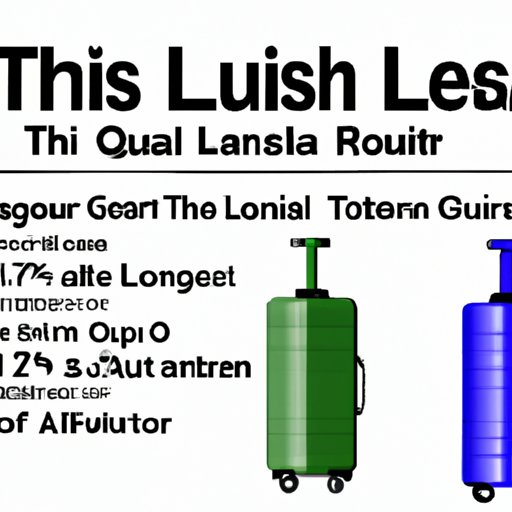
Introduction
Carrying liquids on an airplane has become an increasingly complex issue since the attacks of September 11, 2001. As a result, the Transportation Security Administration (TSA) instituted new rules on the liquids passengers are allowed to bring on board airplanes. Understanding these rules is crucial if you want to avoid delays, fines, or even having your items confiscated altogether. This article will provide an overview of the TSA regulations on carrying liquids on-board an airplane, including how many ounces you can bring with you.
The Ultimate Guide to Understanding Airline Liquid Restrictions on Carry-On Luggage
After the terrorist attacks on September 11th, 2001, the TSA implemented new security measures to ensure the safety of passengers flying in the United States. One such measure was the restriction on liquids brought aboard airplanes. The goal of this measure was to prevent dangerous substances from being carried on board that could be used for terrorist purposes, such as explosives.
When it comes to liquids, the TSA’s rules can seem a bit arbitrary. But they’re grounded in a simple principle: if a liquid can be used as an explosive, it’s prohibited from being carried on board a plane. This includes common liquids like shampoo, mouthwash, and bottled water.
The TSA has identified several items that are allowed in your carry-on luggage and that do not count as liquids. These include certain foods, medicines, and personal care items, such as lipstick or mascara. However, in most cases, these items must be presented separately and declared at the security checkpoint.
Navigating the Rules: How Many Ounces of Liquids Can You Bring on a Plane?
The TSA limits the amount of liquid that can be brought on an airplane in order to prevent explosives from being smuggled onboard. The standard limit is 3.4 ounces (100 milliliters) per item. However, the TSA does allow passengers to bring multiple containers, so long as they are placed in a resealable plastic bag that is no larger than 1 quart in size. This is commonly referred to as the “3-1-1 rule.”
There are some exceptions to this rule. In general, medications, baby formula, and breast milk are allowed in larger quantities so long as they are declared and presented separately at security checkpoints. Duty-free liquids may also be allowed in larger quantities as long as they are in a secure, tamper-evident bag.
It’s important to note that the TSA’s liquid restriction applies to both carry-on and checked luggage. If you have a larger amount of liquid that you need to transport, it’s recommended that you check it in or ship it ahead of time.
TSA Liquid Guidelines: How to Pack for Your Next Flight
Packing liquids for air travel can be a challenge, but there are ways to make the process easier. Here are a few tips:
- Use travel-sized products whenever possible. These are designed to fit within the TSA’s restrictions, and they can be found at most drugstores and online.
- Place liquids in a resealable plastic bag before packing them in your carry-on. This will make it easy for you to take them out during security screening.
- Consider packing non-liquid products, such as powder deodorants or toothpaste tablets, instead of liquid ones. This can help you reduce the amount of liquids you need to pack.
One of the most helpful ways to ensure that your liquids stay under the limit is to take advantage of every inch of space in your carry-on bag. This means using products that are multi-purpose, such as a tinted moisturizer that doubles as a foundation, or packing a solid shampoo bar instead of a liquid bottle.
Maximizing Your Carry-On: How to Fit All Your Liquids Within the Allowed Ounce Limit
If you’re struggling to fit all your liquids within the TSA’s ounce limit, there are a few things you can do to make life easier:
- Invest in travel bottles. These small, refillable containers allow you to bring the liquids you need without taking up too much space in your carry-on.
- Roll your liquids. Instead of packing your liquids flat, try rolling them up to save space.
- Consider packing solid versions of your favorite products. This includes solid shampoo bars, toothpaste tablets, and even face wash bars.
Another great way to ensure you fit all your liquids within the TSA’s limit is to plan ahead. Before you travel, ask yourself which liquids you really need to bring with you. You might find that there are some items you can leave behind, such as a bulky moisturizer or extra bottles of water.
What Happens if You Bring Too Many Ounces of Liquids on a Plane?
If you do accidentally bring too many ounces of liquid on board, there are a few things that may happen. First, you may experience a delay as TSA officers perform additional screening. Second, you may be asked to dispose of the excess liquids, which can be a waste of time and money. Finally, you may have items confiscated.
If you find that you have too many liquids with you at the security checkpoint, don’t panic. You may be able to re-pack your items in your checked luggage, or give them to someone who is not traveling. If you are unsure about the rules for a specific liquid item, be sure to ask a TSA officer before you travel.
Conclusion
Carrying liquids on board an airplane can be a challenging experience, but following the TSA’s rules makes the process easier. Remember to pack your liquids in 3.4-ounce containers or smaller, and to place them in a clear, resealable bag. Be sure to declare any necessary items during security screening, and remember that medications, baby formula, and breast milk are allowed in larger quantities if they are presented separately.
Following these simple tips will help ensure that your next flight goes as smoothly as possible. Packing responsibly with liquids is important for the safety of others on board and will prevent delays and confiscations.




